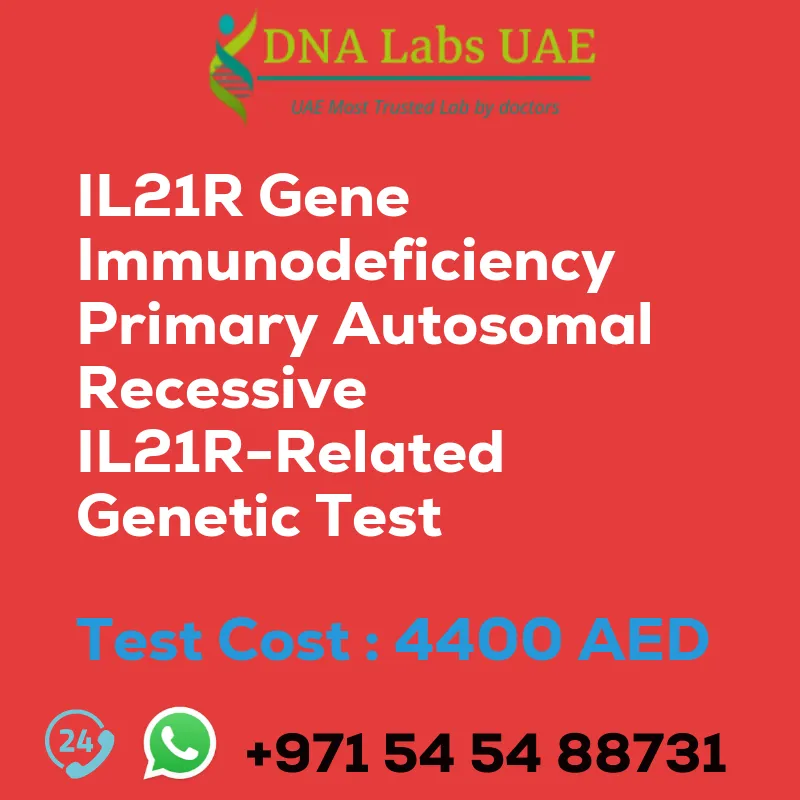IL21R Gene Immunodeficiency – Genetic Lab Blog
Test Name: IL21R Gene Immunodeficiency primary autosomal recessive IL21R-related Genetic Test
Components:
- Price: 4400.0 AED
- Sample Condition: Blood or Extracted DNA or One drop Blood on FTA Card
- Report Delivery: 3 to 4 Weeks
- Method: NGS Technology
- Test Type: Osteology Dermatology Immunology Disorders
- Doctor: Dermatologist
- Test Department: Genetics
Pre Test Information:
Clinical History of Patient who is going for IL21R Gene Immunodeficiency, primary, autosomal recessive, IL21R-related NGS Genetic DNA Test. A Genetic Counselling session to draw a pedigree chart of family members affected with IL21R Gene Immunodeficiency, primary, autosomal recessive, IL21R-related NGS Genetic DNA Test gene IL21R.
Test Details:
IL21R gene immunodeficiency is a primary immunodeficiency disorder that is inherited in an autosomal recessive manner. This means that individuals with this condition must inherit two copies of the mutated IL21R gene, one from each parent, in order to have the disorder. The IL21R gene provides instructions for making a protein called interleukin-21 receptor (IL-21R). This receptor is found on the surface of certain immune cells and plays a critical role in the immune system’s response to infections and diseases.
Mutations in the IL21R gene can lead to a decrease in the production or function of the IL-21R protein. This can result in a weakened immune response and an increased susceptibility to recurrent infections, particularly respiratory tract infections.
To diagnose IL21R gene immunodeficiency, a genetic test called IL21R-related NGS (Next-Generation Sequencing) can be performed. This test analyzes the IL21R gene for any mutations or variations that may be present. It can identify specific genetic changes that are responsible for the immunodeficiency and help confirm the diagnosis.
Genetic testing for IL21R gene immunodeficiency can be helpful in identifying individuals who may be at risk for the disorder. It can also assist in providing genetic counseling to affected individuals and their families, as well as guide treatment options and management strategies.
| Test Name | IL21R Gene Immunodeficiency primary autosomal recessive IL21R-related Genetic Test |
|---|---|
| Components | |
| Price | 4400.0 AED |
| Sample Condition | Blood or Extracted DNA or One drop Blood on FTA Card |
| Report Delivery | 3 to 4 Weeks |
| Method | NGS Technology |
| Test type | Osteology Dermatology Immunology Disorders |
| Doctor | Dermatologist |
| Test Department: | Genetics |
| Pre Test Information | Clinical History of Patient who is going for IL21R Gene Immunodeficiency, primary, autosomal recessive, IL21R-related NGS Genetic DNA Test. A Genetic Counselling session to draw a pedigree chart of family members affected with IL21R Gene Immunodeficiency, primary, autosomal recessive, IL21R-related NGS Genetic DNA Test gene IL21R |
| Test Details |
IL21R gene immunodeficiency is a primary immunodeficiency disorder that is inherited in an autosomal recessive manner. This means that individuals with this condition must inherit two copies of the mutated IL21R gene, one from each parent, in order to have the disorder. The IL21R gene provides instructions for making a protein called interleukin-21 receptor (IL-21R). This receptor is found on the surface of certain immune cells and plays a critical role in the immune system’s response to infections and diseases. Mutations in the IL21R gene can lead to a decrease in the production or function of the IL-21R protein. This can result in a weakened immune response and an increased susceptibility to recurrent infections, particularly respiratory tract infections. To diagnose IL21R gene immunodeficiency, a genetic test called IL21R-related NGS (Next-Generation Sequencing) can be performed. This test analyzes the IL21R gene for any mutations or variations that may be present. It can identify specific genetic changes that are responsible for the immunodeficiency and help confirm the diagnosis. Genetic testing for IL21R gene immunodeficiency can be helpful in identifying individuals who may be at risk for the disorder. It can also assist in providing genetic counseling to affected individuals and their families, as well as guide treatment options and management strategies. |








